In Part 1, I reported details on Paterson Animal Shelter’s high kill rate. In this blog, I will examine whether the shelter complies with state shelter laws. In addition, I will discuss ways the shelter can turn things around.
Illegal Killing During Seven Day Protection Period
Under state law, shelters cannot kill either owner surrendered or stray animals until seven days pass. The purpose of this law is to provide owners a chance to reclaim their lost pets and prevent shelters from immediately killing animals. In practice, the New Jersey Department of Health allows shelters to euthanize animals during this seven day period if facilities meet both of the following conditions:
- If a veterinarian deems euthanasia necessary for humane reasons to prevent excessive suffering when illness and injury is severe and the prognosis for recovery is extremely poor
- Only a licensed veterinarian should perform euthanasia in the above situation and they must clearly document the rationale in the animal’s medical record
Paterson Animal Shelter illegally killed animals during the seven day protection period on a massive scale. In 2015, the shelter killed 125 cats and dogs, 47 cats and 78 dogs during this seven day protection period. Remarkably, Paterson Animal Shelter killed 71% of the cats and dogs, 98% of the cats and 61% of the dogs it killed in 2015 during this seven day period. Even worse, Paterson Animal Shelter killed 96 out of the 125 (77%) cats and dogs, 41 out of the 47 (87%) cats and 55 out of the 78 dogs (71%) it killed during the seven day protection period on the very first day. Thus, Paterson Animal Shelter killed large numbers of animals during the seven day protection period and on the very day many of these animals entered the shelter.
Paterson Animal Shelter killed large percentages of owner surrendered animals during the seven day protection period. Specifically, Paterson Animal Shelter killed 23% of owner surrendered cats and dogs, 12% of owner surrendered cats and 33% of owner surrendered dogs during the seven day protection period.
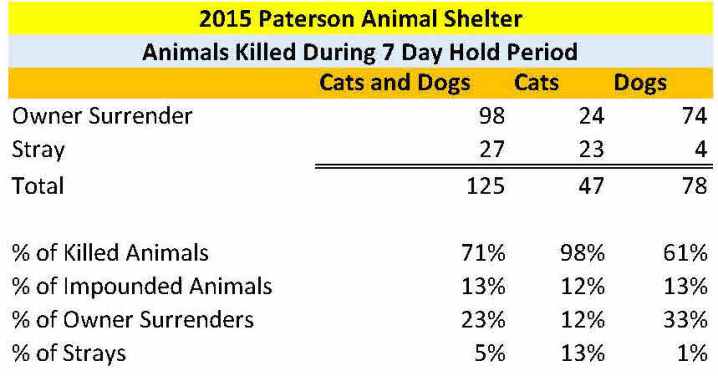
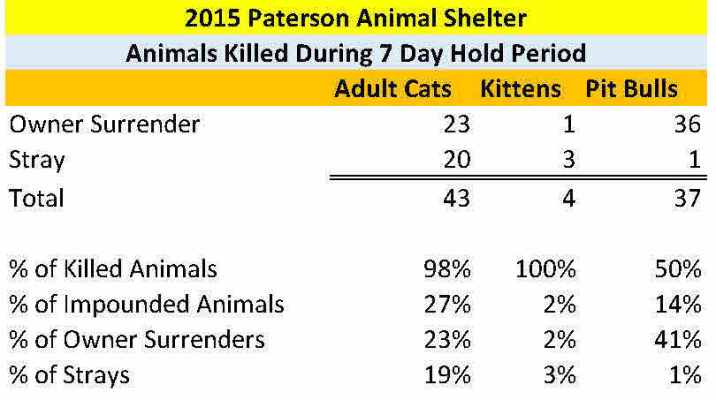
Paterson Animal Shelter had none of the legally required documentation that would allow it to euthanize these animals during the seven day protection period. While the shelter wrote things like “sick”, “grave condition”, and “tumor” in the records of some of these animals, the shelter provided no veterinary records documenting these animals were truly hopelessly suffering and that the veterinarian euthanized the animal as required by state law. In a small number of cases, the shelter mentioned some of the animals were taken to its outside veterinarian and euthanized, but this is not sufficient to comply with state law. Therefore, the shelter violated state shelter law even if some of these animals were hopelessly suffering.
The shelter killed many animals during the seven day protection period for convenience. In fact, Paterson Animal Shelter killed 27 of the 78 dogs (35%) during the seven day protection period for behavioral reasons. The shelter also killed 7 of the 47 cats (15%) for behavioral reasons that clearly indicated the animals were not hopelessly suffering.
Dog ID# 47962 was a 4 year old female Cane Corso surrendered by her owner to the Paterson Animal Shelter on December 6, 2015. Based on the shelter’s record keeping methodology described in the second image below, the date in the upper right corner indicates when the dog was killed. Paterson Animal Shelter killed this Cane Corso in the prime of her life after just 2 days and stated she was “very vicious” as the reason. Even if this dog was truly dangerous to people and would not respond to behavioral rehabilitation efforts (impossible to determine after just 2 days), a shelter can never kill a dog for behavioral reasons until seven days go by. Even worse, Paterson Animal Shelter illegally killed this dog after the New Jersey Department of Health sent out a directive on October 20, 2015 clarifying state law requiring shelters to not kill owner surrendered and stray animals during the seven day protection period. Thus, Paterson Animal Shelter illegally killed this dog.
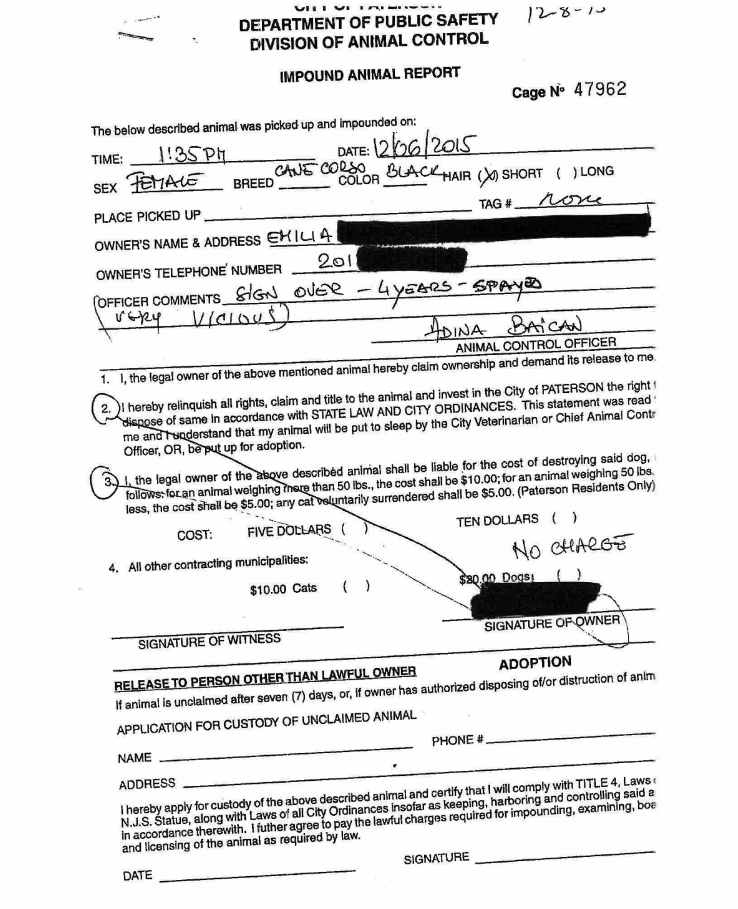
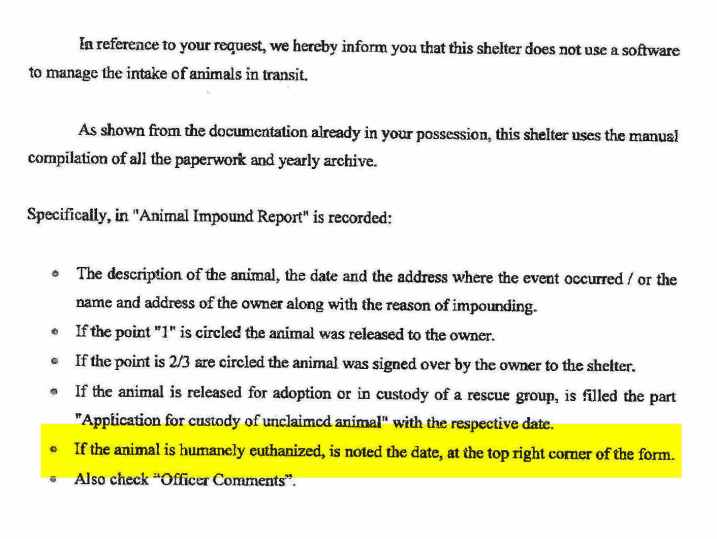
Ghost was a 5 year old pit bull surrendered by his owner to the Paterson Animal Shelter on November 30, 2015. After just one day, Paterson Animal Shelter illegally killed Ghost for being “not friendly.”
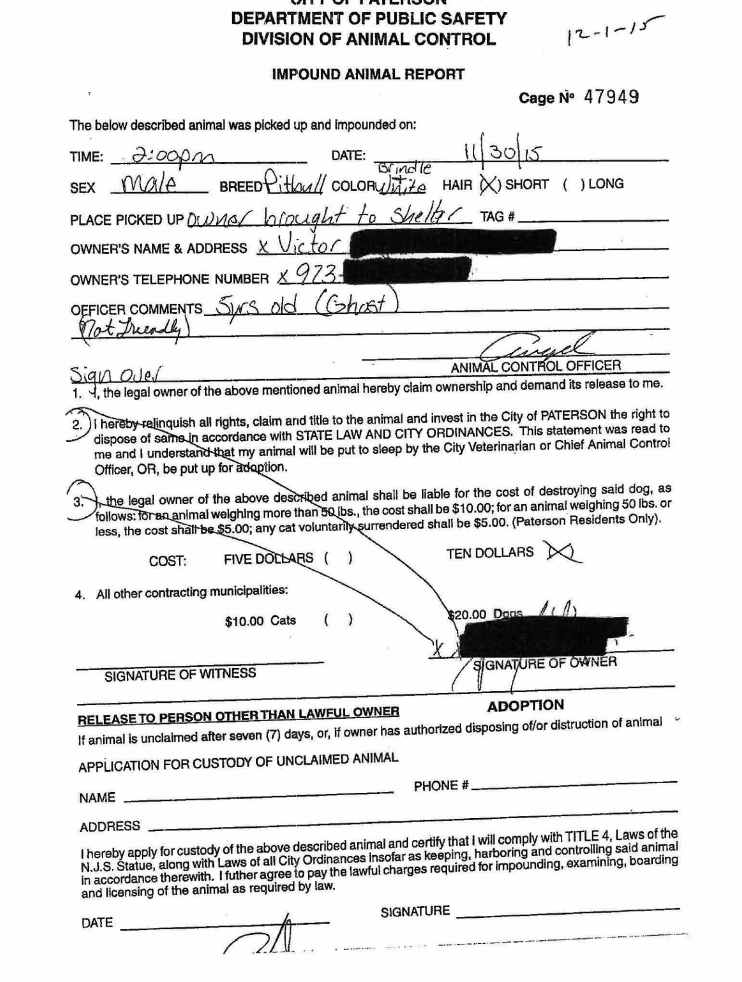
Dog ID# 48012 was a female mixed breed dog surrendered by her owner to the Paterson Animal Shelter on December 29, 2015. Despite state law prohibiting the killing of owner surrendered animals for seven days, Paterson Animal Shelter killed this dog on the day she arrived at the facility for being “not adoptable.”
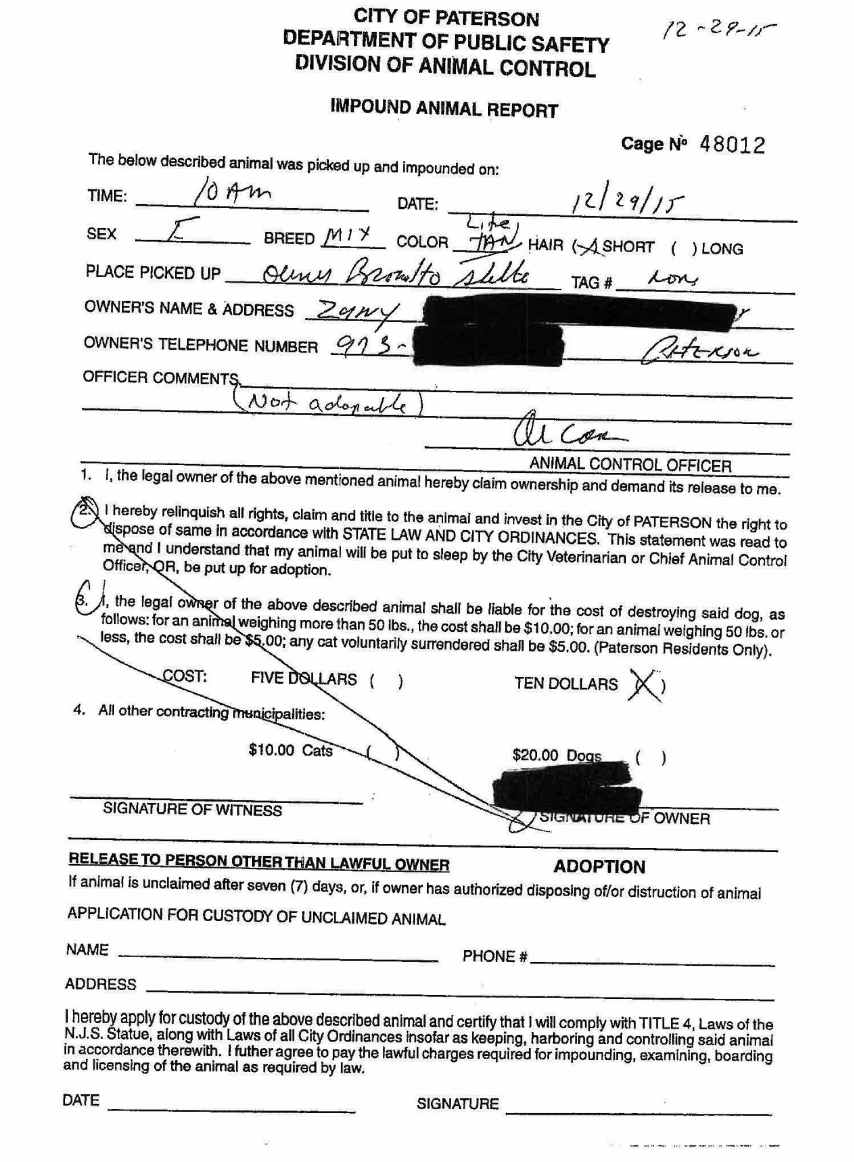
Cat ID# 47557 contained 2 white and gray cats that were surrendered by their owner to the Paterson Animal Shelter on July 24, 2015. Despite having an owner, Paterson Animal Shelter deemed both cats “wild” and “not friendly” and killed the two animals on the day they arrived at the facility per the euthanasia log below. Clearly, no one can determine if cats are feral, particularly ones that had an owner, as soon as they arrive at a shelter. However, even if these cats were truly feral, Paterson Animal Shelter cannot kill them until seven days pass. Thus, Paterson Animal Shelter illegally killed these two cats.
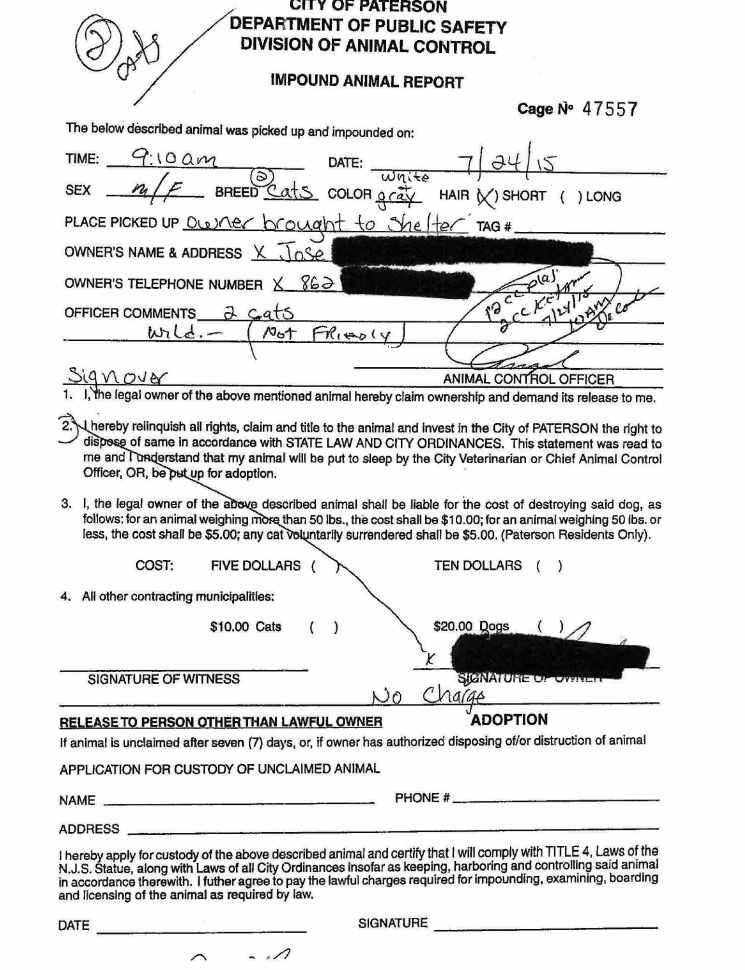
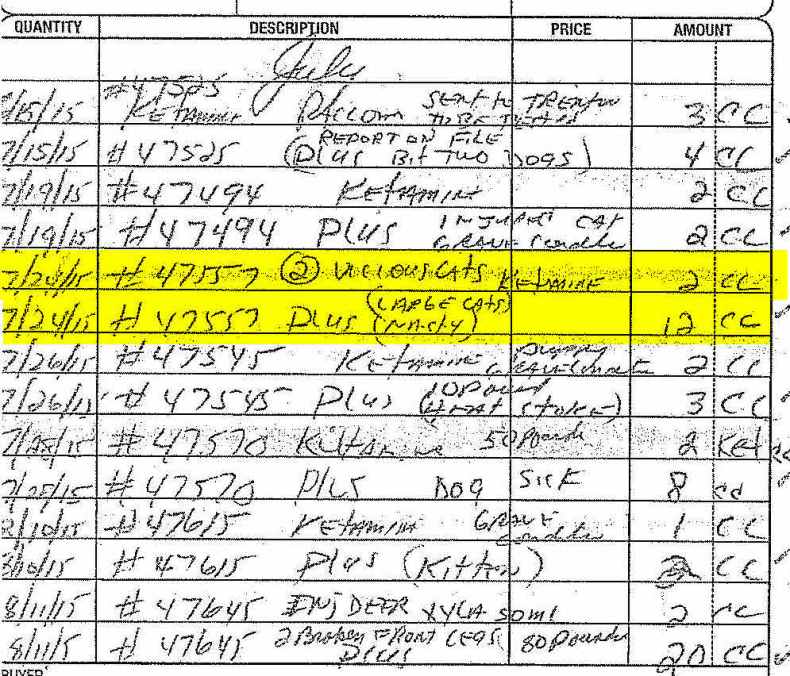
Dog ID# 47955 was a 1 year old pit bull surrendered to the Paterson Animal Shelter on December 2, 2015. Paterson Animal Shelter killed this young dog six days later for being “sick”, but did not provide any additional details. The shelter provided no veterinary records to prove this animal was hopelessly suffering for this or any other animal despite my OPRA requests for such information. Thus, Paterson Animal Shelter appeared to illegally kill this young dog during the seven day protection period.
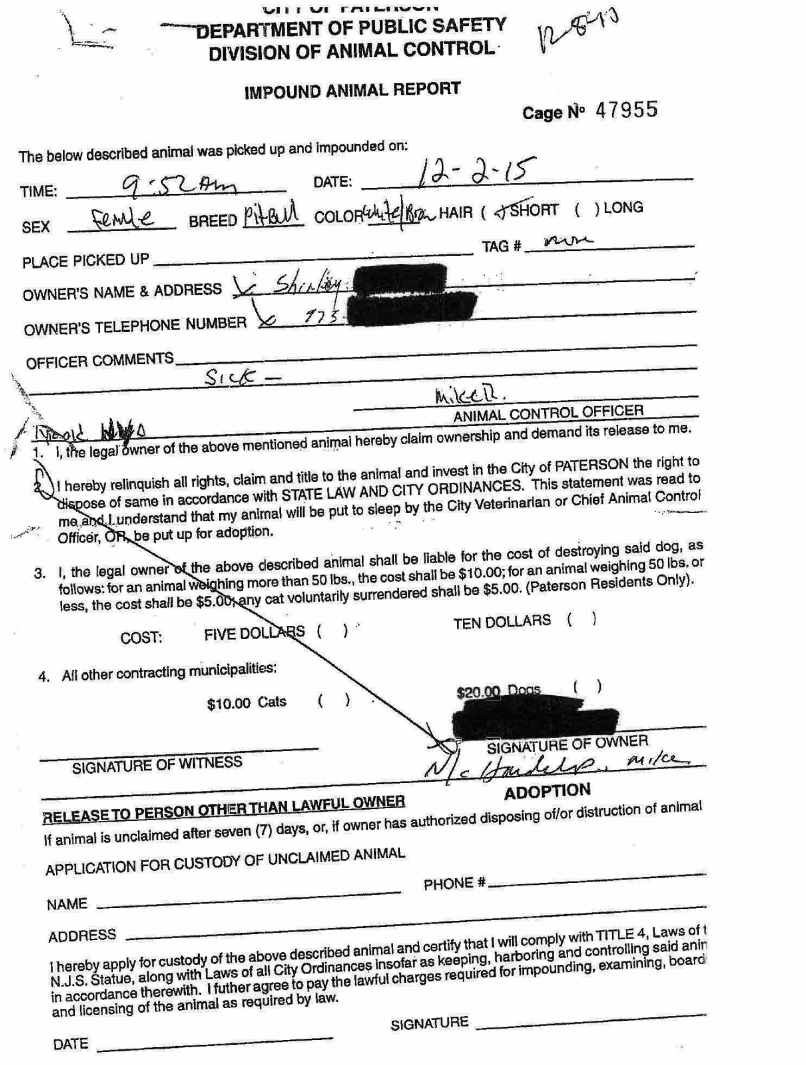
Dog ID # 47630 was a 4 year old pit bull surrendered to the Paterson Animal Shelter on November 17, 2015. On that same day, Paterson Animal Shelter killed this dog for being “sick”, but provided no documentation that the dog was hopelessly suffering. Thus, Paterson Animal Shelter appeared to illegally kill this dog during the seven day protection period.
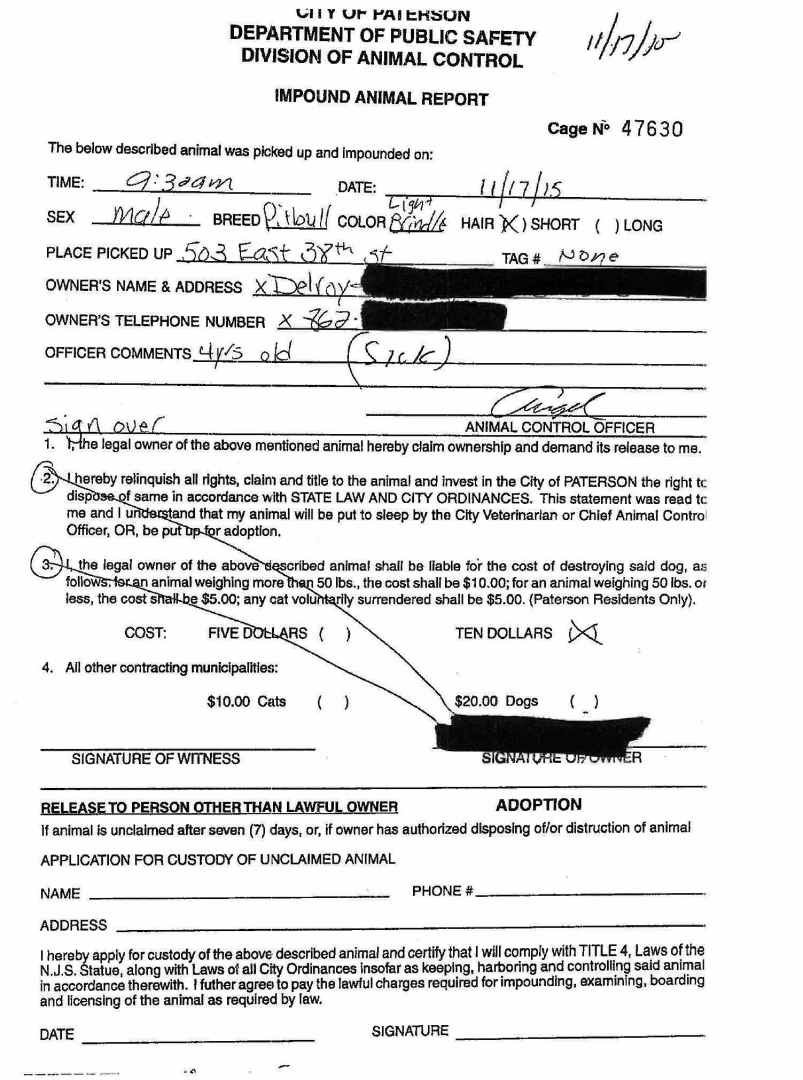
Cat ID # 48010 contained 5 cats that were surrendered by their owner to the Paterson Animal Shelter on December 29, 2015. The record also stated it had 6 cats, but I assume that was a mistake. The shelter’s euthanasia log shows the shelter killed all 5 cats on the day the animals arrived at the facility. Paterson Animal Shelter simply wrote “old” and “sick”, but provided no veterinary documents to prove the animals were hopelessly suffering and euthanized by a veterinarian. Most importantly, it is next to impossible that all 5 cats were hopelessly suffering. Thus, Paterson Animal Shelter clearly violated the seven day protection period.


Records Raise Serious Questions as to Whether Paterson Animal Shelter Humanely Euthanizes Animals
Paterson Animal Shelter’s euthanasia records do not specify how the shelter killed or euthanized animals. Specifically, the records do not state whether the shelter euthanized/killed each animal by an intravenous (preferred method), intraperitoneal or intracardiac (i.e. heart sticking) injection. Per New Jersey law, shelters can only use intraperitoneal injections on comatose animals and neonatal kittens. Under this method, animals are injected in the abdominal cavity and can take up to 30 minutes to die. Heart sticking, as the name implies, involves stabbing an animal in the heart with Fatal Plus poison and New Jersey shelters can only use this method on heavily sedated, anesthetized or comatose animals. Thus, Paterson Animal Shelter’s euthanasia records do not indicate whether animals are in fact humanely euthanized in accordance with state law.
Paterson Animal Shelter chooses to sedate rather than comfort animals prior to euthanasia. Specifically, the shelter injected ketamine or xylazine into nearly every animal to restrain them prior to administering a poison to kill the animals. The Humane Society of the United States Euthanasia Reference Manual states shelters should avoid using a preeuthanasia anesthetic and hold and comfort animals when appropriate:
When appropriate, it is often best practice to hold and comfort an animal for direct IV or IP injection of sodium pentobarbital rather than injecting a preeuthanasia anesthetic, but neglecting or refusing to use pre-euthanasia drugs when direct injection would cause the animal undue stress is equally ill-advised.
Paterson Animal Shelter’s decision to sedate virtually every animal instead of comforting these creatures speaks volumes about how the shelter feels about animals. While some animals are aggressive and require sedatives, surely a good number of these animals were not vicious or incapable of being comforted.
To make matters worse, Paterson Animal Shelter’s use of pure ketamine as a pre-euthanasia drug is cruel. The Humane Society of United State Euthanasia Reference Manual states shelters should not use ketamine alone to sedate an animal for killing as it makes the animal’s muscles rigid and the injection stings so much that the animal reacts very negatively to it. If that was not bad enough, large doses can cause convulsions and seizures.
Ketamine (available commercially as Ketaset, Ketaject, and others) is an anesthetic agent that renders an animal completely immobile. However, when used alone it can cause the muscles to become rigid, causing the body to stiffen. It also stings so much upon injection that it creates a fairly pronounced reaction in most animals. Moreover, in large doses it can produce convulsions and seizures. For these reasons, ketamine is recommended for use only when combined with another drug (like xylazine to create PreMix, above), that tempers these negative effects
Paterson Animal Shelter’s use of another pre-euthanasia sedative, pure xylazine, is not humane and also puts shelter staff at risk. The Humane Society of the United States Euthanasia Reference Manual recommends shelters not use xylazine alone as it may cause vomiting, the animal to act violently to sudden noises and movements, the animal to bite, and makes it more difficult to inject the euthanasia drug.
Despite these advantages, xylazine is not recommended for use as a pre-euthanasia drug by itself because: a) it commonly causes vomiting, particularly in cats and in any animal that has recently eaten; b) though sedated, the animal remains conscious, and may react violently to sudden noises and movements; c) it may dangerously reduce the animal’s natural bite inhibition, making it potentially even more dangerous to handle; and d) it lowers the animal’s blood pressure to the point that it can be difficult to inject the sodium pentobarbital for euthanasia. For these reasons, xylazine is recommended for use only when combined with another drug (like ketamine to create PreMix, above), that tempers these negative effects.
Euthanasia and Intake and Disposition Records Do Not Comply With State Law
Under N.J.A.C. 8:23A-1.11(f) 3 and 4, shelters must weigh each animal and keep a log of those body weights as well as the drugs used to immobilize and euthanize the animals.
Establish and maintain, in accordance with N.J.A.C. 8:23A-1.13, euthanasia records that contain the body weight and dosage of all euthanasia, immobilizing, and tranquilizing agents administered to each animal.
Many of Paterson Animal Shelter’s euthanasia logs failed to document the weight of the animals killed/euthanized. Additionally, many of the weights listed had suspiciously round numbers like 20 pounds, 25 pounds, 70 pounds, etc. that possibly point to shelter staff estimating weights. If animals received too small of a dose of euthanasia drugs due to not being weighed, it is possible some animals were dumped or put into an incinerator still alive.
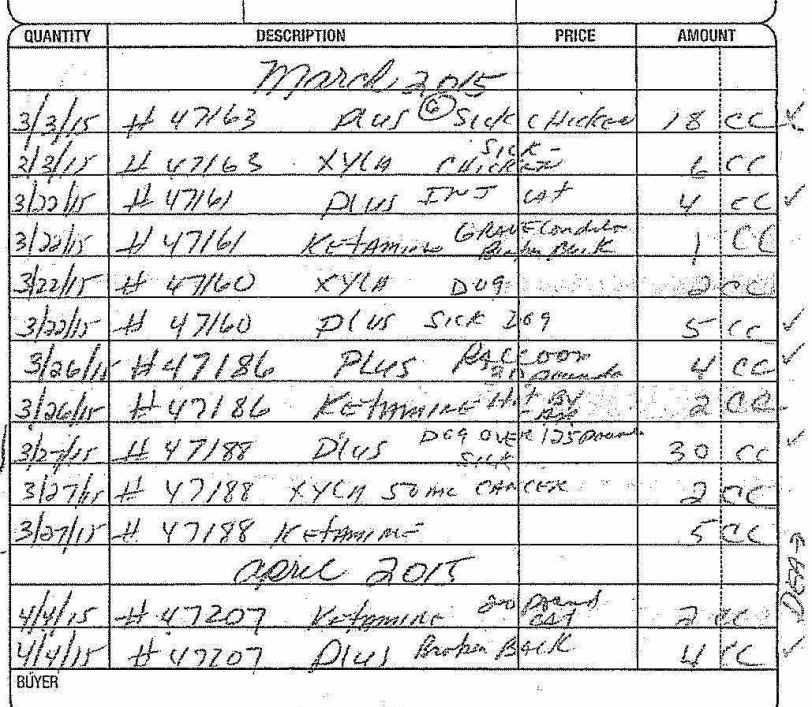
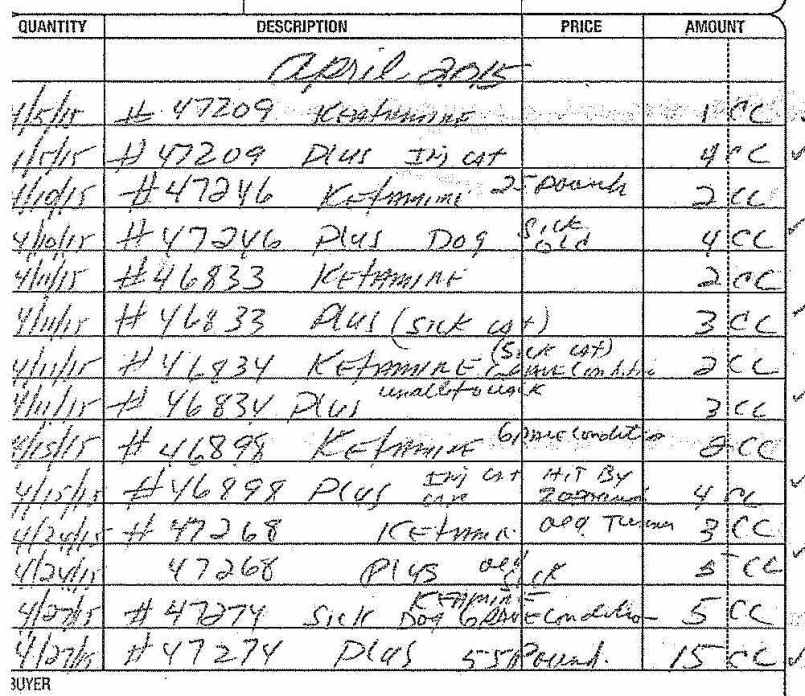
N.J.A.C. 8.23A-1.13(a) requires shelters keep intake and disposition records containing the following information for each animal the facility impounds:
There shall be kept at each kennel, pet shop, shelter or pound a record of all animals received and/or disposed of. Such record shall state the date each animal was received, description of animal, license number, breed, age and sex; name and address of person from whom acquired; date euthanized and method, or name and address of person to whom sold or otherwise transferred.
Most of Paterson Animal Shelter’s intake and disposition records did not include the animal’s age. Additionally, most of the shelter’s cat intake and disposition records also did not list the animal’s breed. Finally, many of the shelter’s records contained multiple animals on the same record under the same ID number. Therefore, Paterson Animal Shelter did not retain all the required information for each impounded animal as the New Jersey Department of Health explained in its August 26, 2009 inspection report on Associated Humane Societies-Newark.

Shelter Lacks Any Records Proving it Provides Veterinary Care and Has a Disease Control Program
Under N.J.A.C. 8.23A 1.9(d), animal shelters must provide “at least prompt basic veterinary care” to “sick, diseased, injured or lame animals.” In practice, New Jersey Department of Health inspectors require shelters to retain veterinary records to prove the shelter complies with this law.
Paterson Animal Shelter did not maintain veterinary records during 2015. Despite my repeated OPRA requests, the shelter stated it had no veterinary records at the shelter or with its outside veterinarian.
Furthermore, Paterson Animal Shelter’s veterinarian invoices listed no explanation for the services performed. Specifically, Blue Cross Dog and Cat Hospital charged the City of Paterson $2,000 a month for unknown services. Based on both the shelter and veterinarian providing me no medical records, I have to assume the City of Paterson pays this veterinarian to act as the supervising veterinarian, to kill animals, and do little else.
As a result of Paterson Animal Shelter’s lack of any veterinary records, the shelter appears to provide little to no veterinary care to its animals other than killing.
Under N.J.A.C. 8.23A 1.9(a), shelters “shall establish and maintain a program of disease control and adequate health care (program) under the supervision and assistance of a doctor of veterinary medicine.” Furthermore, “the program shall address the physical and psychological well-being of animals at the facility, including stress-induced behaviors, such as repetitious behavior or vocalizations, from auditory, visual, and olfactory stimuli.” Finally, the supervising veterinarian must sign a form certifying such a program is in place. Thus, animal shelters must develop a program to address physical and mental disease at their facilities.
Paterson Animal Shelter has no written policies and procedures. Specifically, the City of Paterson’s response to my request for such policies and procedures stated the shelter follows the state’s shelter laws. In other words, the shelter has no written disease control program let alone other policies, such as intake, adoption, and rescue. Frankly, it is stunning that the animal shelter in the state’s third largest city has no documented policies.

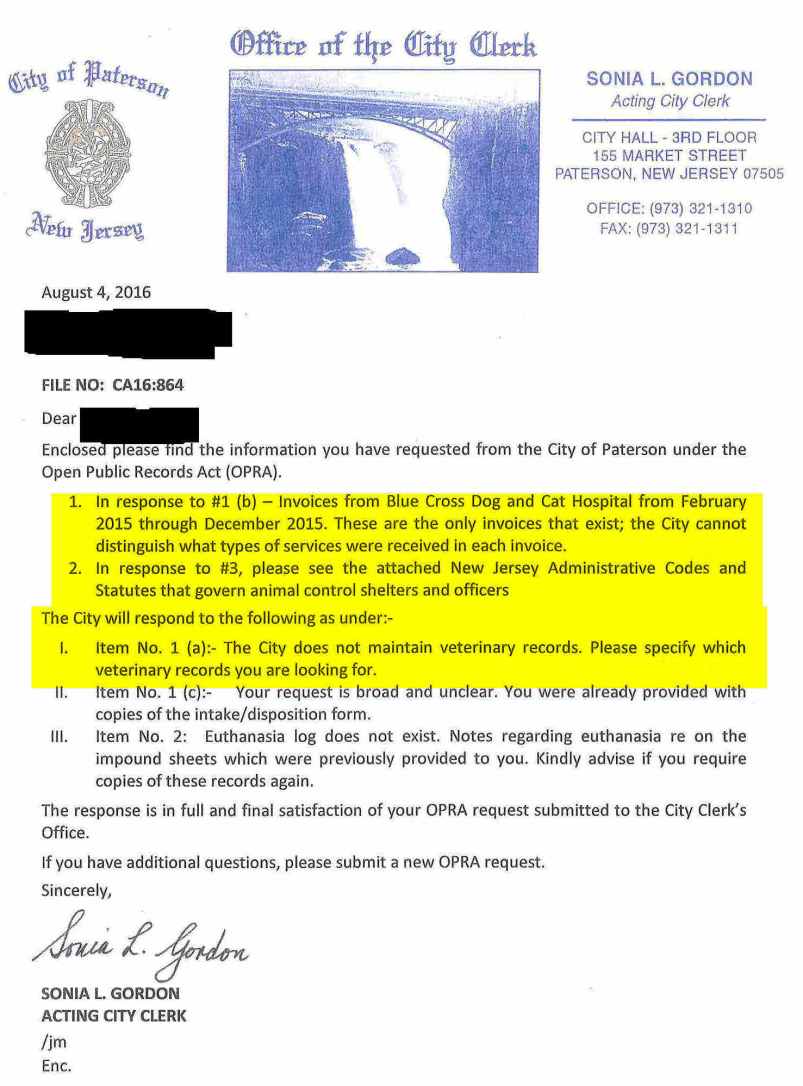
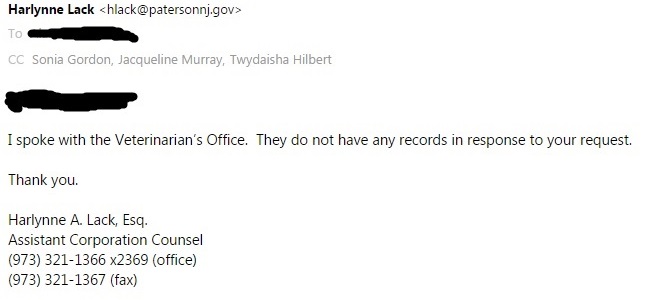
Shelter May Violate Operating Hours Law
Under N.J.A.C. 8.23A 1.10(b), an animal control shelter must have public access hours to allow people to reclaim their lost pets. The law states “the hours for public access shall be at least two hours each business day Monday through through Friday and two hours Saturday or Sunday, excluding legal holidays.”
Paterson Animal Shelter’s compliance with the law is questionable. On weekends, the shelter is only open by appointment only from 9 am to 3 pm. Based on my interpretation of the law, being open by appointment only on weekends does not meet the public access requirement. Regardless, any shelter requiring people make an appointment to visit the facility on weekends is not serious about saving lives. Similarly, the shelter’s very limited weekday hours, which are limited to two hours in the morning and one hour in the afternoon, make it extremely difficult for working people to reclaim, rescue or adopt an animal.
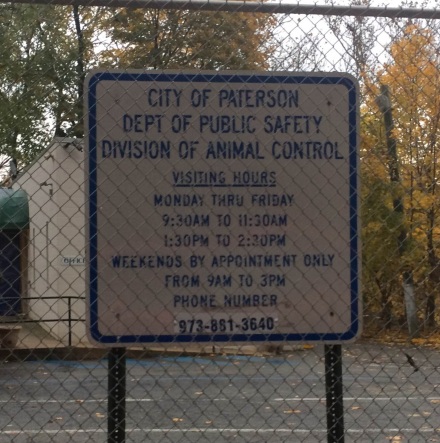
Paterson Division of Health Fails to Perform Proper Annual Shelter Inspections
Under N.J.A.C. 8.23A 1.2(b), the local health authority must inspect an animal shelter each year and issue a certificate indicating the shelter complies with state shelter laws. After requesting the Paterson Division of Health’s 2014, 2015 and 2016 Paterson Animal Shelter inspection reports, the City of Paterson could only provide a June 15, 2015 inspection report. Subsequent to my request, the Paterson Division of Health conducted its 2016 inspection on November 29, but this inspection occurred five and half months after the required deadline for the annual inspection (i.e. 2016 inspection occurred seventeen and half months after the 2015 inspection). Presumably, the Paterson Division of Health did not inspect the Paterson Animal Shelter in 2014 and the shelter therefore should not have had a license to operate during 2014 and for five and half months in both 2015 and 2016.
The Paterson Division of Health’s 2015 and 2016 inspection reports provide no confidence that the shelter complies with state shelter laws. The 2015 inspection, which took just an hour and half, missed all the shelter’s illegal killing of animals during the seven day protection period, the lack of a documented disease control program and veterinary records, missing required information in the intake and disposition and euthanasia records, and possible violations of the public operating hours requirement on weekends. In fact, the inspection report’s only comment stated “No Chapter 23A violations observed at the time of this inspection.” Similarly, the 2016 inspection report also only wrote essentially the same comment. Thus, the Paterson Division of Health failed to do even the most basic inspection.
Local health departments typically fail to properly inspect animal shelters. Under New Jersey animal shelter law, local health departments must inspect animal shelters each year. In reality these entities are ill-equipped to inspect animal shelters. Local health departments are used to inspecting places, such as restaurants, which are far different than animal shelters. Furthermore, the same health department that inspects Paterson Animal Shelter is under the same municipal government as the animal shelter. Clearly, this is a conflict of interest and recent experience in the state shows it plays out in poor quality inspections.
Passaic County SPCA Fails to Crack Down on Illegal Killing
The Passaic County SPCA has jurisdiction over the shelter and can enforce animal cruelty laws. For example, the Passaic County SPCA could potentially file animal cruelty charges related to the shelter illegally killing certain animals during the seven day protection period. Stuart Goldman, who is the former President and Chief Humane Law Enforcement Officer for the Monmouth County SPCA, recently brought such a case alleging this against the Gloucester County Animal Shelter.
The Passaic County SPCA has an inherent conflict of interest in enforcing animal cruelty laws against the Paterson Animal Shelter. The Paterson Animal Shelter Chief Animal Control Officer, John Decando, also is a law enforcement officer with the Passaic County SPCA. Thus, the Passaic County SPCA’s lack of action is not surprising.
Shelter Budget Reflects Misguided Priorities
Paterson spends almost its entire shelter budget on employee salaries. The shelter’s 2015 budget reveals the Paterson Animal Shelter allocated $270,234 for its ACO salaries and $25,000 for a part-time veterinarian. Shockingly, 93% of the shelter’s budget went to pay the shelter’s ACOs and its shelter veterinarian (who provided no details on the services he performed in 2015). Even worse, virtually none of the remaining $23,900 in the shelter’s budget seems to go to saving lives. For example, $5,200 goes to janitor services and another $7,000 is allocated to a “clothing allowance.” One has to wonder why ACOs need $7,000 to buy clothes? Thus, the Paterson Animal Shelter appears to allocate virtually no money to saving the animals the public expects it to save.
Paterson Animal Shelter has enough funds to save lives. While the Paterson Animal Shelter’s budget is not huge, it still received $327 per dog and cat impounded during 2015 ($252 per dog and cat using the facility’s 2015 Shelter/Pound Annual Report animal intake figures). As a comparison, Michigan’s Chippewa County Animal Shelter, which also serves an impoverished area, received $242 per dog and cat and saved 98% of the 402 dogs and 488 cats it took in during 2015. In contrast to Paterson Animal Shelter, Chippewa County Animal Shelter relies heavily on volunteer and foster programs to save lives.
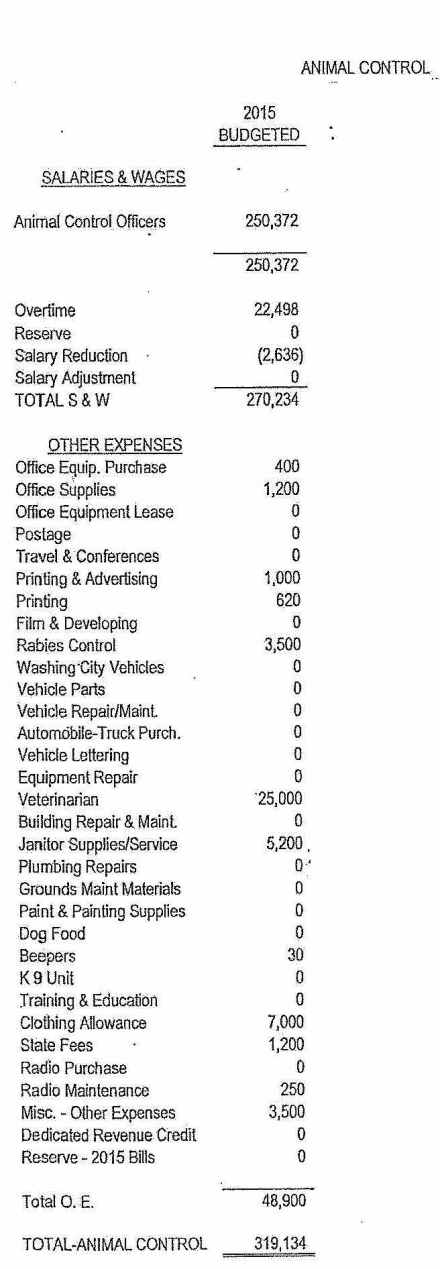
Shelter Must Comply with State Law
The Paterson Animal Shelter has some positive things going for it. Many times the shelter waived fees for people surrendering as well as reclaiming animals due to hardships. Additionally, the shelter has low owner reclaims fees that help increase the chance animals are returned to owners. Finally, the shelter worked very closely with Second Chance Pet Adoption League and Start II rescue to save many animals.
That being said, Paterson Animal Shelter has significant problems that it must immediately address to comply with state law. Paterson Animal Shelter must cease killing animals, whether stray or owner surrenders, during the seven day protection period unless a veterinarian documents why the animals are hopelessly suffering and that veterinarian euthanizes the animal. The shelter and its veterinarian must create a written disease control program addressing both the physical and mental needs of its animals. Furthermore, the shelter must provide veterinary care to animals at the shelter and retain all records to document it is doing so. Also, the shelter must develop specific euthanasia protocols, which must include weighing animals and using recommended euthanasia procedures in the Humane Society of United State Euthanasia Reference Manual. Finally, Paterson Animal Shelter must include all required animal information, such as age and breed, in its intake and disposition records and remain open for at least two hours on weekends. Thus, Paterson Animal Shelter must do many things to comply with the bare minimum standards in state shelter laws.
Chief Animal Control Officer Must Turn Shelter Around or Resign
Chief ACO, John DeCando, has been the face of the Paterson Animal Shelter for more than four decades. Mr. DeCando has led the animal shelter since 1975 and often is covered in the media. Unfortunately, Mr. DeCando only appears to contact the media to bring the spotlight on himself. For example, he frequently gives interviews about animal cruelty cases portraying himself as a hero, but to my knowledge never uses the media to save animals at his shelter.
John DeCando came under fire in recent years for collecting huge sums of money. From 2006 to 2010, Mr. DeCando claimed he was on call after hours and entitled to double time pay totaling $144,000 despite not doing any actual work approximately 80% of the time. Even worse, John DeCando’s own union president stated Mr. DeCando was not entitled to this pay. In fact, John DeCando’s subordinates only logged less than a month of this overtime during this five year period suggesting Mr. DeCando kept this sweet money for almost nothing deal entirely for himself. One has to wonder how many dogs, cats and wild animals could have received veterinary care with John DeCando’s $144,000 windfall?
While John DeCando’s failures at the Paterson Animal Shelter are serious, I do think Paterson should give him the opportunity to turn the shelter around. Mr. DeCando is charismatic and has the ability to run the shelter at a high level if he chooses to do so. He also has done some good things, such as waiving fees in hardship cases. Also, city officials do not seem to help him much with the shelter. As such, Paterson’s elected officials should give John DeCando a reasonable period of time to bring the shelter into compliance with state law and enact progressive lifesaving policies to increase the shelter’s dog live release rate to at least 95% and its cat live release rate to 92% or higher.
Paterson Animal Shelter Must Implement Lifesaving Policies
Paterson Animal Shelter should create a pet surrender prevention program to reduce intake at this space constrained facility. Nearly 40% of the dogs and more than 50% of the cats arriving at Paterson Animal Shelter were surrendered by their owners. If the shelter is coercing owners, who love their animals, to surrender their pets, then the shelter needs to cease doing so. Ideally, Paterson Animal Shelter would reach out to a group like Downtown Dog Rescue, which runs a highly successful pet surrender prevention program on behalf of the South Los Angeles City Shelter and three other municipal shelters, to learn how it can recruit a private organization to volunteer at the Paterson Animal Shelter to help families keep their pets. In 2015, Downtown Dog Rescue kept 1,172 pets, including 1,063 dogs and 108 cats, out of the South Los Angeles Shelter at an average cost per animal ranging from $50 to $150. Downtown Dog Rescue helps struggling pet owners pay fees, fines, and pet care costs and fix broken fences and dog houses. Paterson Animal Shelter can also reach out to national organizations, such as the ASPCA, Best Friends and HSUS, to seek guidance on recruiting such an organization as well as obtaining any additional funding that may entice a private group to run a shelter intervention program.
Paterson Animal Shelter can also move towards managed intake for owner surrenders. Under a managed intake program, a shelter uses various techniques to slow down and reduce intake. For example, a shelter will typically require owners to wait for a short period of time, such as a week, or make an appointment to surrender an animal. At the same time, the shelter will offer advice and provide materials to solve various pet problems. Often times, pet owners reevaluate their decision and keep the animal during the short wait period. However, the shelter must always immediately take in an animal the pet owner refuses to keep during this short period or if the pet is in a dangerous situation. As a result of this program, Lynchburg Humane Society found 60% of people wanting to surrender their pets ended up keeping their animal or rehomed the animal themselves with no increase in pet abandonment. Similarly, Liberty Humane Society in Jersey City achieved a live release rate of around 90% after instituting an appointment program.
The City of Paterson must ensure all animals are vaccinated upon arriving at the shelter to reduce the risk of disease. In the case of owner surrenders, the shelter should vaccinate the animals prior to the waiting period discussed above to ensure the animal has time to build immunity. In the end, this small investment will save the shelter money, particularly since it will need to hold animals longer to comply with state law.
The City of Paterson must shift money from animal control to lifesaving and heavily rely on volunteers. Given virtually all of the shelter’s budget is paid to ACOs, the shelter should reallocate a substantial portion of these funds to actually care for animals. Additionally, the shelter should recruit a “Friends” group to help raise funds for the shelter. To assist the effort, the City of Paterson should create a clear plan to reach a 90% plus live release rate and attain no kill status. Furthermore, the shelter should actively recruit volunteers to help in all aspects of caring for animals and getting those pets quickly into good homes. Simply having a single rescue make pleas to pull dogs from an unnamed shelter is not enough.
The shelter must stay open for many more hours to allow people to save animals. Specifically, the shelter must stay open seven days a week for at least six hours each day and include weekday evening hours. Simply put, people cannot reclaim, rescue or adopt dogs and cats if the shelter is often closed.
Paterson Animal Shelter must create a high volume adoption program. Currently, people can adopt unaltered and unvaccinated animals for $28, but the shelter makes no effort to market animals. Unsurprisingly, Paterson Animal Shelter only adopted out 3 cats and 15 dogs in 2015. Obviously, the shelter must vaccinate and alter all animals it adopts out. Furthermore, it should do so immediately for owner surrenders and right after the hold period for strays. The shelter can use volunteers to take attractive photos and videos, write engaging profiles, and market the animals on social media and adoption web sites. Additionally, John DeCando, who is very savvy with the media, should use his connections to frequently promote adoption, particularly when the facility is at near capacity.
Paterson Animal Shelter and nearby facilities should create a coalition to rescue dogs and cats. Based on my recent analyses on New Jersey animal shelter performance for dogs and cats, Paterson Animal Shelter would still need to send a substantial number of animals to rescues or other shelters even if it adopts out animals at a good rate. Specifically, Paterson Animal Shelter should have sent 232 dogs and 156 cats to rescues and/or other facilities in 2015. While Paterson Animal Shelter exceeded those goals, placing so many animals with rescues puts an unfair burden on these cash-strapped groups and also prevents rescues from saving animals from other shelters. As a result, other nearby shelters should step up and take animals from Paterson Animal Shelter after the facility runs out of space.
Paterson Animal Shelter can team up with a number of nearby shelters to save all of the facility’s healthy and treatable animals. If other nearby shelters perform as they should and quickly move animals out of their facilities, they can easily save Paterson Animal Shelter’s animals. For example, the nearby Wayne Animal Shelter, Ramapo-Bergen Animal Refuge and Pequannock Animal Shelter could save all healthy and treatable dogs that the Paterson Animal Shelter lacks the space to adopt out. Similarly, both Ramapo-Bergen Animal Refuge or Wayne Animal Shelter could single-handedly rescue all of the cats that Paterson Animal Shelter lacks the space to adopt out. Furthermore, many other nearby shelters could also help as well. Thus, Paterson Animal Shelter and nearby animal shelters can easily end the killing in the area.
Recently, Paterson Mayor, Joey Torres, expressed interest in moving the shelter to a more accessible location, expanding it, and adopting out animals. While I have doubts as to whether Paterson has the funding to build a proper animal shelter, these remarks do indicate the city’s elected officials could be receptive to turning this shelter around.
The City of Paterson must change course at its shelter. In an impoverished city with widespread corruption at the highest levels of government, Paterson desperately needs something to inspire residents. Turning around the Paterson Animal Shelter with local residents playing a key role fits the bill. Allowing youth, working families and senior citizens the opportunity to build something wonderful helps people as much as the animals they are caring for. If Paterson’s elected officials do turn this shelter around, they will not only help their animals and voters, but also their own political careers. Will they do the right thing?

I find it outrageous & frankly unacceptable that the chief ACO for the Paterson Shelter is also a Humane Law Enforcement Officer with the PASSAIC COUNTY SPCA, yet this facility is rife with violations & blatant disregard of both NJ shelter & cruelty laws! As an officer in one of njspca’s county chapters one should expect nothing short of a model shelter. It is beyond comprehension that an spca officer has run this animal shelter in such an archaic manner & with little to no priority on life saving initiatives for FOUR decades. Wtf???!
LikeLike
He only wants the spotlight on himself. Selfish bastard.
LikeLiked by 1 person
Do you know if any funds/resources were or are available to or for this shelter?
LikeLike
The shelter receives taxpayer funds. Additionally, the shelter can seek grant funding, but has not to the best of my knowledge.
LikeLike
That would require work NJAO. PaperWORK.
LikeLike
trying to find an update on this and i can’t
http://www.nj.com/passaic-county/index.ssf/2015/05/dogs_rescued_from_fighing_ring_stolen_from_paterso.html
LikeLike
They continued to operate the same way in 2016.
LikeLike
there’s a video, and article, I will try to find it,where decando expresses severe shock that this happened,however,how shocked can you be,when its the second time fighting dogs were ‘stolen’, and that is 2x I know about. where there more times? it should never have happened to begin with. those dogs should have been sent to a secret, safe location, both times.it just leaves questions in my mind of what’s really going on. as an spca officer, he knows this has happened at other shelters. so why would he put dogs seized from a Paterson fight in the paterson pound? but to do it yet again a second time? and act so surprised it happened again? come on now.
LikeLike